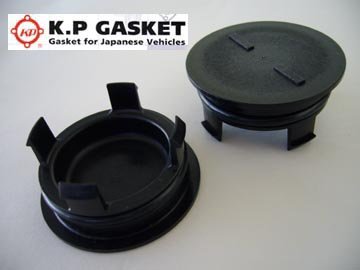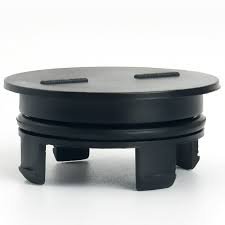Ohh, looks like they are
91302-GE0-000?
Yes, that's correct.
I would avoid the aluminum cam caps- most of the designs out there tend to leak because the O-rings they use to seal aren't sufficient enough to expand and contract through the years of the engine's heating and cooling cycles. Most people who install them don't keep their NSX long enough to see the leaks happen. The rubber caps- if installed correctly- will last the entire TB service interval without leaking. I use Hondabond HT, although I was originally taught to install them dry. My method looks like this:

The three "ribs" seal the splash oil and flex as the head expands and contracts from the heat cycles. Placing the Hondabond after the third rib provides a final barrier for any oil that makes its way past the ribs as the caps age and harden. I also put another thin layer of HB on the outside of the caps as well.

You should also replace the cam seals on the other end of the engine. Make sure to seat them evenly- if they are set even a little bit crooked, you will get oil leaks. I use a micrometer depth gauge to make sure the seal is the same distance from the housing all the way around.
I recommend replacing the crank seal, since it is a time and not just miles interval. The part is cheap and will likely last the rest of the life of the car. Same with the crank pulley. If you don't replace it, at least install a shield from Cedar Ridge or T3TEC so if your pulley grenades, it won't kill your engine.
I also recommend replacing the front cover (the metal ones) bushings, as the ones in there are probably hard and crusty. Same goes for the front timing cover gaskets- there are several of them. I don't recommend re-using 24-year old rubber anywhere on the engine.
@Spoolinfool is right and you should try to replace the oil cooler hoses and pedestal gasket while you have access. They are a royal pain and best to change them out before they fail. NSX engines have been lost due to these particular hoses. Make sure to set the hose clamps in an orientation where the tabs won't rub the hose above and are easy to reach if you need to get to them next time. I hate it when lazy dealer techs put the tabs between the hose and the engine block!
Since you are draining the coolant and replacing the water pump, it might be a good time to think about doing the rest of the hoses. It's also a good time to check your radiator for leaks. The OEM Honda radiator lasts about 20 years before the plastic tanks start to separate from the aluminum core.
Remember, the most important thing to do on this job is make sure all surfaces are surgically clean before applying any Hondabond or rubber gaskets. The number 1 cause of oil leaks on the NSX engine is sloppy installs from a failure to clean, usually because dealer techs are rushing and just wipe everything down with a dirty shop rag. Wipe everything with an acetone soaked microfiber cloth.
BTW, your timing belt is original. I can tell from the markings.












